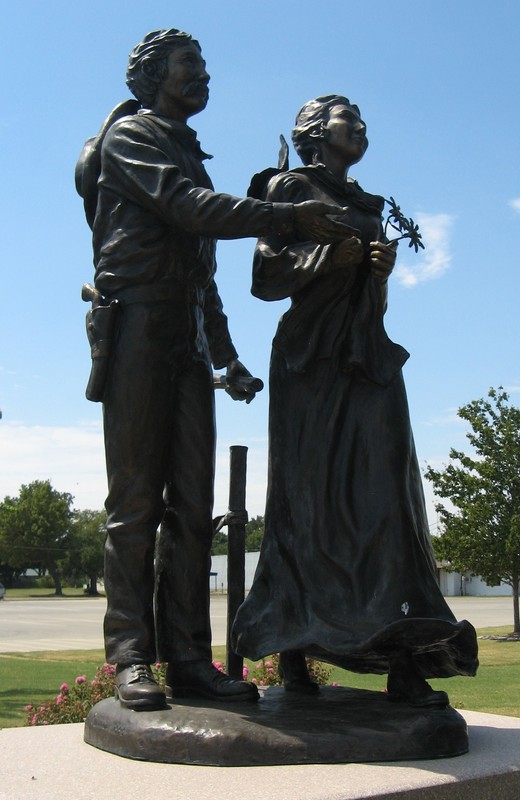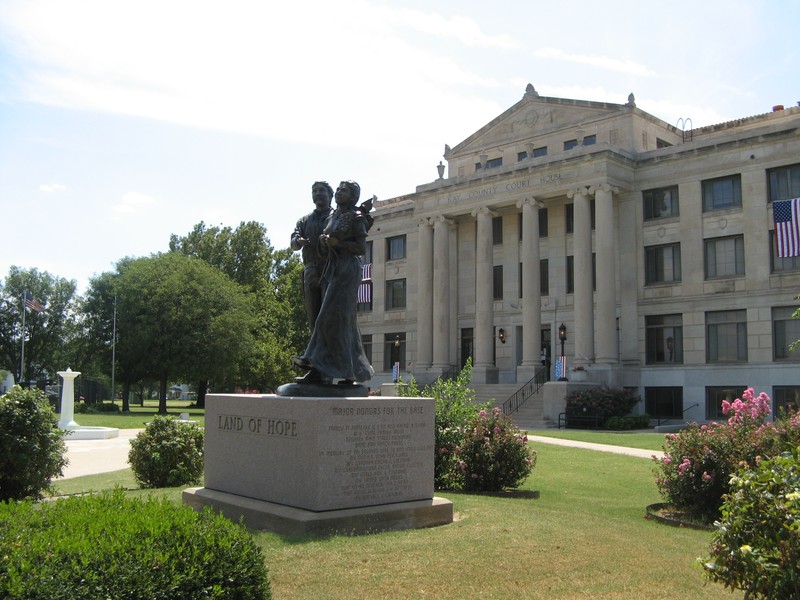Land of Hope
Introduction
Text-to-speech Audio
Bronze monument commemorating the centennial of the 1893 Cherokee Strip Land Run. In contrast to other Oklahoma land run monuments that focused on homeseekers rushing in to stake their claim, local artist Bernadette Carman portrayed a couple gazing out over their chosen homestead.
Images
Land of Hope detail

Land of Hope

Backstory and Context
Text-to-speech Audio
Sculpted by Newkirk native Bernadette Carman, Land of Hope portrays a pioneer man and woman gazing out over their new land claim. A claim stake stands at their feet. Dedicated in 1994 to celebrate the centennial of the 1893 Cherokee Strip land run.
"Land Runs" are a historical phenomenon closely associated with Oklahoma. When American settlers moved westward in the mid-19th century, Oklahoma was designated as "Indian Territory"--land set aside for Native Americans. Native groups pushed out of the eastern United States were relocated onto the homelands of Indigenous peoples within that Indian Territory. Portions of those land were then taken by the US federal government and opened to homesteading, primarily by white Americans.
The 1893 Cherokee Outlet Opening was the fourth and largest land run in Oklahoma. Economic pressures during the so-called Panic of 1893 combined with poor planning and enforcement made it even more chaotic than previous Oklahoma land runs. The 1893 run produced widespread suffering and several deaths.[1]
The Cherokee Outlet was one of three areas that the Cherokee people acquired under the Treaty of New Echota that guided their removal from the southeastern United States. But large portions of those recently granted Cherokee lands were taken under the 1866 Reconstruction Treaties. The federal government relocated smaller Native tribes onto the eastern third of the Cherokee Outlet. Construction of railroads through Cherokee lands encouraged cattlemen and homesteaders to occupy the region.[2]
For the past half century, Oklahomans have erected monuments that celebrate the excitement of settlers rushing in to stake a land claim on former Native lands. Perry, Ponca City, and Enid, Oklahoma, also erected monuments marking the 1893 land run centennial.[3] While Newkirk's includes a land claim stake, it focuses less on the rush onto the land. Instead, it echoes pioneer monuments elsewhere in the United States that depict young couples or families gazing hopefully out over their newly claimed lands.[4]
Sources
- Turner, Alvin O.. Cherokee Outlet Opening, The Encyclopedia of Oklahoma History and Culture. Accessed February 17th, 2024. https://www.okhistory.org/publications/enc/entry.php?entry=CH021.
- Turner, Alvin O.. Cherokee Outlet Opening, The Encyclopedia of Oklahoma History and Culture. Accessed February 17th, 2024. https://www.okhistory.org/publications/enc/entry.php?entry=CH021.
- Swain, Joseph Benjamin Norris. "Claims to History: Commemorating Progress in Oklahoma Territory, 1989-2007." University of Oklahoma, 2008.
- Prescott, Cynthia Culver. Pioneer Mother Monuments: Constructing Cultural Memory. Norman, Oklahoma. University of Oklahoma Press, 2019.
Photo by David Prescott
Photo by David Prescott
